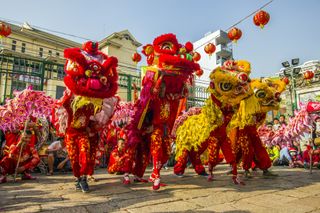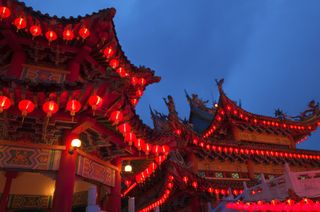Chinese New Year: celebrate the coming of spring

This article has been updated with dates for 2021.
The Chinese New Year, also known as the Lunar New Year — and in China, more commonly known as the Spring Festival (Chūnjié) — has become one of the world's top five most celebrated festivals. Other East Asian and Southeast Asian countries such as Korea, Japan, Vietnam, Singapore, Malaysia, Thailand, Indonesia, Mauritius and the Philippines celebrate with their own traditions, as well. Chinese New Year celebrations also take place in New York, London, Vancouver, Sydney and many other overseas cities. One-sixth of the world's population participates in celebrating the Lunar New Year, according to the Travel China Guide.
The Chinese New Year is the longest public holiday in China. Employees have seven to 12 days off from work, and students have one month of winter vacation.
"No matter where they live, Chinese try to return home to be with their families for Chinese New Year, just as Americans do for Christmas," said Dr. Ming Wang, an ophthalmologist and advocate for cultural diversity in Nashville, Tennessee. "This creates the world's largest annual migration, known as the Spring Festival Travel Rush."
In 2020, Lunar New Year festivities in China were partially curtailed by the onset of the COVID-19 pandemic. According to a paper published in The Lancet, the Chinese government enacted some protective measures to promote social distancing and prevent travel of infected people. In 2021, travel and gatherings before the holiday were once again restricted, according to the New York Times.
When is the lunar new year?
The Spring Festival is celebrated either in January or February depending on a "lunisolar" calendar, a combination of a lunar or moon-based calendar and a solar calendar like the one that is used in much of the Western world. (Most dates internationally are expressed in the Gregorian calendar, which is based only on the Earth's orbit around the sun.)
The traditional calendar uses lunar months, but adds in a solar component to account for drift. Some years, an extra lunar month is needed to keep the new year in its correct alignment with the seasons.
"The Chinese New Year falls on the first day of the first month in the lunar calendar," Jianguo Chen, associate professor of Chinese at the University of Delaware, told Live Science. That's usually the second new moon after the winter solstice. In the Gregorian calendar, the first day of the festival occurs on the new moon between Jan. 21 and Feb. 20.
In 2021, the Lunar New Year will be celebrated on Feb. 12.
The Chinese lunisolar calendar is divided into lunar cycles of 60 years, and each cycle is further divided into five smaller cycles of 12 years each. Each year is represented by an animal in the Chinese zodiac: rat, ox, tiger, rabbit, dragon, snake, horse, sheep, monkey, rooster, dog and pig. In 2021, the sign of the Chinese zodiac will transition from the rat to the ox.
"Traditional Chinese timekeeping relies on a sexagesimal system, called 'Heavenly Stems and Earthly Branches,'" Lotus Perry, instructor in Chinese language and culture at the University of Puget Sound in Tacoma, Washington, and director of the Chinese Reconciliation Project Foundation in Tacoma, told Live Science. "The matching of the 10 stems and 12 branches (stem-branch), paired with the 12 zodiac animals, yields a total of 60 possible combinations."
History in China
The holiday is believed to have originated during the Shang Dynasty (1600 to 1100 B.C.) as a spring carnival in which people offered sacrifices to gods and ancestors at the end of the winter, welcoming the arrival of the spring, Chen said. It became a public holiday in 1914 during China's Republican period, but celebrations were banned in 1967 during the Cultural Revolution. The festival was later reinstated.

Chinese traditions and customs for the new year
"Guo Nian Hao" — which means "Happy New Year" — is a common Chinese New Year greeting, Chen said. Chinese also greet each other with blessings such as 恭喜发财 ("gōngxǐ fācái" in Mandarin) or ("Kung hei fat choi" in Cantonese), meaning "Wishing you a happy and prosperous Chinese New Year!"
"The Spring Festival is the most important holiday in China and is celebrated as such," Chen said. "On Chinese New Year's Eve, all family members will try their very best to travel back home, no matter how far away they may be (even on the other side of the world) to enjoy the family reunion feast known as nián yè fàn."
Before the new year comes, it is customary for people to completely clean their houses to get rid of bad fortune from the old year and decorate their tidy houses, all with an atmosphere of rejoicing and celebration. Homes are often decorated with vertical banners featuring two lines of poetry, folk paintings, intricate paper cuttings (similar to cutouts of paper snowflakes), festive scrolls and lanterns. Decorations are usually bright red. "Basically, red decorations are to the Chinese New Year festival what Christmas trees are to Christmas," Wang said.

The decorations are typically red because in the Chinese culture, the color can bring happiness, wealth and prosperity by warding off evil spirits and bad luck. The tradition may have come from the story of the Nian. This fierce and cruel creature eats livestock and children, but it is scared of the color red, along with fire and noise, according to Reader's Digest. People celebrate with red decorations and fireworks to drive away the Nian.
Various kinds of celebratory activities, sponsored either by the government or communities, occur throughout the celebration, including Shehuo, an ancient folk art that includes lion and dragon dances, acrobats, stilt walkers, opera performances and drum performances.
"One of the most interesting holiday entertainment programs organized by CCTV (China Central Television) over the past three decades is the CCTV Chinese New Year's Gala, which is typically a 5-hour long evening holiday entertainment program, featuring a variety show of drama, dance, music and comedy," Chen said. "Broadcast worldwide, the gala attracts a yearly viewership of over 800 million viewers. The Chinese are so enamored by this New Year Gala that to host the New Year Eve's family reunion feast without watching it would be a regretful experience."
A variety of foods are served during the New Year festival, such as dumplings ("jiaozi"), rice cakes ("niangao"), spring rolls and fish. "The Chinese traditionally prepare sumptuous feasts during the holiday, featuring fish, pork, chicken and duck, in addition to various kinds of fruit, candies and nuts. Dumpling is a must, particularly in northern China," Chen said.
Gifts are also given. "Instead of wrapped gifts like Americans give at Christmas, Chinese of all ages exchange red envelopes stuffed with 'lucky money,' from older to younger, from bosses to employees, and from leaders to underlings," Wang said. "The children get to spend their lucky money however they want."
The last day of the 15-day celebration is the Lantern Festival. It includes various kinds of activities, including folk dance, eating "yuánxiāo" (rice balls with various kinds of fillings), playing games of riddles, setting off fireworks and organizing festive parades enhanced by lanterns of various styles. "This festival is sometimes known traditionally as China's Valentine's Day when singles hope to meet with a companion," Chen said.
Additional resources
- More on the lunar calendar and what calendars tell us about culture from the New York Times
- Princeton University: The Spirits of Chinese Religion
- East Asian Institute at Columbia University: The Lunar New Year: Rituals and Legends
This article was updated on Feb. 10, 2021 by Live Science Reference Editor Vicky Stein.
Sign up for the Live Science daily newsletter now
Get the world’s most fascinating discoveries delivered straight to your inbox.

